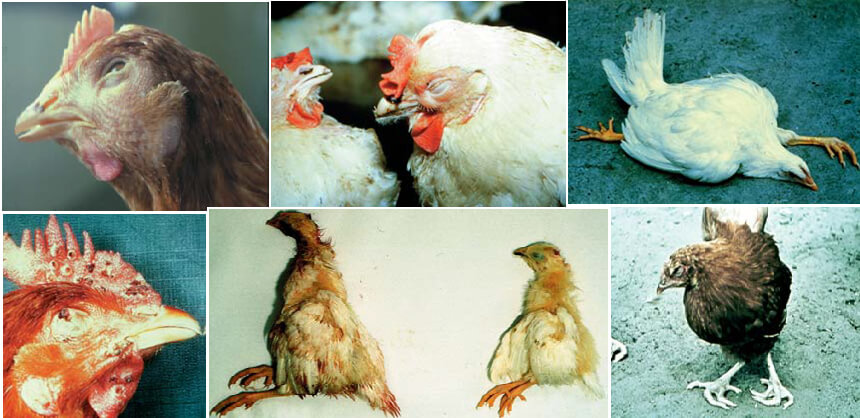Nutritious likes feeds, clean waters, access to fresh and also the adequate housing are most important to have the health of your flocks. Good management and sanitation are the practices are very essential also. Proper ventilation system in the brooder and coop will reduce the moisture and also diseases organisms. Caked or wet a litter should be removed as early as possible to forms to keep the house to remain clean and dry.
Poultry Disease Control and Prevention
For the most backyard a poultry enthusiasts, diseases are the rare as long as the flock doesn’t come to contact with the other flocks. The most common disease for the young and unmedicated flocks are coccidiosis, and that is characterized by diarrhea, unthriftiness and some other mortality. A medicated chick are feed may help prevent the coccidiosis.
The rigid sanitations program can help to prevent the parasites. If internal parasites becomes a problem then the products to treat them are available from your feeds dealer.
You have to check your flock daily to spot diseases or parasites so that you will start the treatment in right way. For getting more information about the identifying, preventing and treating the poultry diseases and parasites, you may contact your local veterinarian. Your dealer may help you to choose the right feeds to support the nutritional needs of your flocks.
Infectious diseases are not spontaneously appear in the chicken flocks. Almost all the infectious diseases are introduced with a flock that means it goes unnoticed which as inadvertently carring the infectious disease on the shoes or clothing and then tending to the chickens.
Just commonly introductions of disease from equipment, feeds, other animals, pests, vermin, migratory waterfowl, and most commonly, from new chickens are introduced to an existing flocks.
Keep chickens clean
Preventing this disease for the flocks entails proper management and also sanitation practices, such as thorough cleaning of equipment and getting facilities with proper disinfectants, and to minimize or to eliminate the introduction of new chickens in your flock.
Biosecurity measures is a thing such as limiting the contact with the visitors and preventing them contact with other birds such as ducks, sparrows and pigeons will reduce the risk of disease of your chickens.
Disinfect the coop
Examples of Disinfectants
- QUAT-A-MONE
- TEK-TROL DISINFECTANT
- Household bleach (sodium hypochlorite 6 percent): Mix _ cup of household bleach per gallon of water.
- Use Iodine Hand Soap
Routine to disinfect of the chicken coop is one of the most important things which you can do to for your flocks. Here are some things to keep in mind that when disinfecting you should doing the following:
- Clean all coops surfaces with the detergent. Disinfectants the work best on cleaned the surfaces, but remember that a clean surface does not mean a disease-free surface.
- Disinfectants are not a thing to effective immediately after the application – they require at least 30 minutes to destroy the infectious organisms.
- Warm disinfectant solutions to break up residue better than the cold solutions.
- Let all surfaces make dry completely before using. You should remember to follow the manufacturer’s of recommendations for the dilution and also use. Common disinfectants are include by hydrogen peroxide, iodine and also chlorine.
Quarantine chickens if necessary
When an unhealthy chickens are noticed, it is very important to immediately quarantine it and also accurately diagnose these disease. By expediting the treatment of infected birds, you have to prevent more spread of these disease.
Vaccinate chickens for problematic diseases
Vaccination process is seldom used by small-flock owners due to the expense and limited availability of vaccines, the simple lack of disease in small flocks is the presence of disease and the improper diagnosis of disease.
Vaccination need to be performed if birds have had a disease problem in the past record, if they are transported on and off premises and if the birds are continually introduced to an existing flocks.
Good husbandry system should be provide the small-flock owner and hobbyist with the healthy, disease-free chickens without the heavy use of medications.
Don’t Borrow Disease From Your Neighbor
It is completely forbidden that not share birds, lawn and other garden equipment, tools, or poultry supplies with your neighbor or other the birds owners. If you do bring these items home, you must clean and disinfect them before they would reach your property. And remember to clean and disinfect borrowed these items before returning them. Never share items named wooden pallets or cardboard egg cartons because they are porous and cannot be more adequately cleaned and disinfected.
Be aware of top chicken diseases
In general, a sick chicken become less active and retracts its neck become close to its body and has an unkempt appearance all the time, but not all these diseases have the same presentation. Here are 11 common chicken diseases are mentioned bellow:
-
Pecking and Cannibalism
Symptoms: Early signs of continuous toe-picking in chicks, pecking at maturing feathers and growing the chickens, or head and also vent pecking in older chickens. It is more essential to pay a close attention to the whole flocks to determine the difference between the random pecking and problematic behavior of the flocks. Normal flocks behavior is include to establish a “pecking” order.
-
Rickets
Symptoms: Chicks develop rubbery bones that cannot support their body weight. In severe cases, the chicks are unable to walk and die of suffocation as their bones cannot support the muscle movements required for breathing. In marginal cases, chicks have a stiff gait, decreased growth and eventual bone deformities, especially in the legs.
-
Vitamin A Deficiency
Symptoms: Chicken develops a crusty of material in their nostrils and their eyelids, progressing to the accumulation of the cheesy material. In the initial stages, it mimics respiratory diseases. Similarly damage in the throat which makes it swallowing difficult. Deficient in the chicks fail to grow, are more severe depressed and die of organ failure. Adult hens are experience only a drop in eggs production, and breeding birds experience a drop in it’s hatchability.
-
Lice Infestation
Symptoms: Chickens act as nervously, and scratch and peck out themselves frequently. Feathers are looked dry and ruffled. Eventual weight are lost and decreased egg production occurs.
-
Coccidiosis
Symptoms: Chickens exhibit diarrhea, weight are lost and pigmentation loss. Severe infections makes bloody diarrhea and could make fatal without treatment.
-
Ascaridiasis (Roundworm)
Symptoms: Common signs of this disease chickens are diarrhea and lose of weight of the chicken. In severe infestationous, masses that adult worms can be cause of a blockage of the intestine, which can be the fatal if it’s treated. When the large number of larvae or immature worms migrate through the lining of the gut, it might cause severe in inflammation.
-
Capillariasis (Hairworm)
Symptoms: The signs of hairworm infection include the paleness, diarrhea and also wasting. It may be fatal if severe cases are left untreated.
-
Mycoplasmosis
Symptoms: Watery eyes, dirtiness of nostrils, coughing and sneezing are exhibited in chickens and are become slow to develop it. Production of egg, fertility and hatchability are become decreased. Over the time, infection can be lead to the accumulation of a “cheesy” material in the eyelids and sinuses and also noticeable outward swelling.
-
Colibacillosis
Symptoms: Chicken appears listlessness, have ruffled feathers and labored breathing, and become cough frequently. Severely infected chickens may exhibit the diarrhea, swelling, and congestion of the liver and also spleen. Newly hatched chickens sometimes often exhibit a navel infection.
-
Fowl Cholera
Symptoms: Sudden death may occur, sometimes without the signs of infection. The signs of infection may be severe depression, cyanosis (dark-purple discoloration of skin) and mucus coming out of the beak. The chronic form of this disease is usually characterized by the localized infections in the face, wattles, sinuses or joints. Infection in the cranium can be cause twisting of the neck, called torticollis.
-
Fowl Pox
Symptoms: Fowl pox causes it round, raised make lesions with “scabby” centers, usually it is located on the comb, wattle and in the face. And occasionally on the legs. Infections at the lining of the mouth and the windpipe may also occur. The lesions in the throat can be grown to cause a complete blockage and possibly death by the suffocation. Chickens might be temporarily or permanently blinded if lesions spread at the eyes.









Leave A Comment